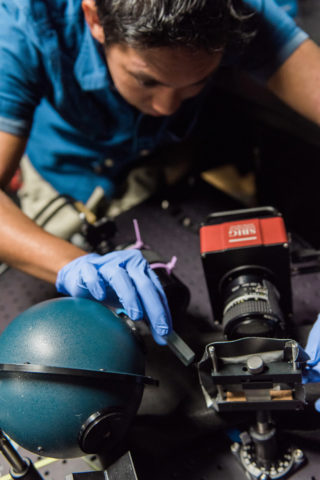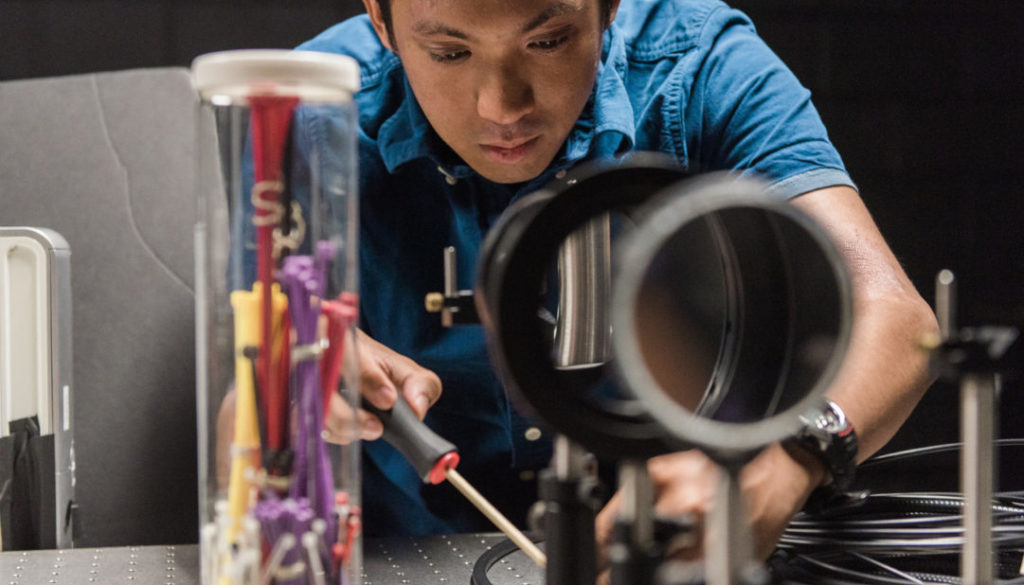Texas A&M Physics Grad Student Pushes Universal Boundaries With Stellar Spectroscopy
Texas A&M University physics graduate student Daniel Nagasawa ’16 has some advice for budding astronomers: Never cease being amazed by things perceived as basic, from light to the elements.
As a member of Texas A&M’s Charles R. ’62 and Judith G. Munnerlyn Astronomical Instrumentation Laboratory, Nagasawa’s passion for astronomy is steered by an unwavering curiosity to uncover the next big clue in the cosmic unknown.
“The biggest challenge is coming to work every day and realizing you are at the frontier of what you know and what you don’t know,” Nagasawa said. “It’s being comfortable at that boundary between knowing and not knowing and trying to push it a little bit further by doing science properly.”
Nagasawa is working on techniques for stellar spectroscopy — the splitting of light into each of its component colors, known as a spectrum, and analyzing its corresponding wavelengths. By studying a star’s spectrum, astronomers can find out crucial details, such as its chemical composition and temperature. These details can open the gateway to other information about the make-up and velocity of the star’s galaxy.
He currently is leading the development of AggieSpec, a low-resolution spectrograph for one of the telescopes at the Astronomical Observatory of Córdoba in Argentina. Nagasawa and his team will use the device — made entirely from commercial components and therefore relatively inexpensive, easily replicable and adaptable to any telescope — to identify quasi-stellar objects and variable stars. Because of the telescope’s location in the southern hemisphere, AggieSpec will also enable spectroscopic follow-up research on objects found in several large-scale imaging surveys, such as the Dark Energy Survey (DES) and Large Synoptic Survey Telescope (LSST), both of which involve Texas A&M.


“In order to understand our place in the universe and how things like the Milky Way, the planets and the galaxies came to be, we need to understand how their elements came to be as well,” Nagasawa said. “You can tell a lot from the chemical evolution of a galaxy just from studying starlight.”
Now in his fourth year in the Munnerlyn Lab, Nagasawa has experienced his share of successes and breakthroughs. But it’s bonding with a group of scientists, united by a love of astronomy, that he says is most rewarding. In particular, he cites lab director Darren DePoy and lab manager Jennifer Marshall, who each have played pivotal roles in his academic career. It’s a feeling that’s mutual.
“Dan is a superstar because he has taken it upon himself to learn and study in great details the techniques to do the science that we are trying to accomplish,” Marshall said. “I really enjoy working with Dan. He’s a great student; he has a great personality; he’s very funny and he tells a lot of jokes — just a fun guy to work with.”
A native of Jersey City, N.J., Nagasawa says he first discovered his love of outer space as a small child when his father took him to a local planetarium. Not long after, a visit through the planetary science exhibits of American Museum of Natural History had Nagasawa hooked. By age 9, he acquired his first telescope. The rest, as they say, was written in the stars.
“You don’t become an astronomer for the money or anything along those lines; you become an astronomer because you want to understand our place in the universe,” Nagasawa said. “If nothing else, astronomy grants you a magnificent perspective, and that’s what I want to achieve.”
Learn more about Texas A&M astronomy or graduate degrees in the Texas A&M Department of Physics and Astronomy.
# # # # # # # # # #
About Research at Texas A&M University: As one of the world’s leading research institutions, Texas A&M is at the forefront in making significant contributions to the storehouse of knowledge, including that of science and technology. Research conducted at Texas A&M represented annual expenditures of more than $820 million in FY 2013, ranking Texas A&M in the top 20 of the National Science Foundation’s most recent survey of research and development expenditures among U.S. colleges and universities. Recently reported FY 2014 research expenditures exceed $854 million. That research creates new knowledge that provides basic, fundamental, and applied contributions resulting in many cases in economic benefits to the state, nation and world. To learn more, visit http://research.tamu.edu.
-aTm-
Watch an interview with Daniel Nagasawa ’16 detailing his research and its importance in the grand scheme of universal things:
Contact: Chris Jarvis, (979) 845-7246 or cjarvis@science.tamu.edu or Dr. Jennifer Marshall, (979) 862-2782 or marshall@physics.tamu.edu
The post Texas A&M Physics Grad Student Pushes Universal Boundaries With Stellar Spectroscopy appeared first on College of Science.
